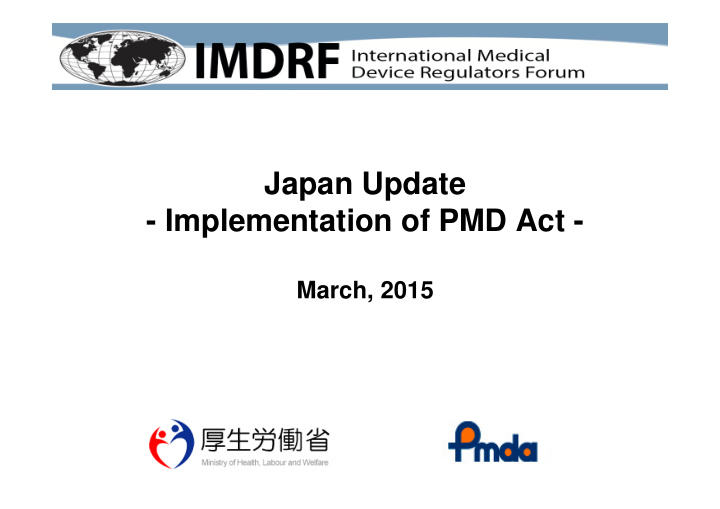



Japan Update - Implementation of PMD Act - March, 2015
Topics • Implementation of PMD Act; Revision of Pharmaceutical Affairs Law (PAL) • PMDA Medical Device Training Seminar 2
Implementation of PMD Act: • The act came into force on 25 November 2014 . • Relevant guidelines for PMD Act have been issued in time. These can be found in the following site (in Japanese): http://www.mhlw.go.jp/stf/seisakunitsuite/bunya/00 00045726.html 3
Brief overview of PMD Act • Salient points; 1. Strengthen safety measures regarding drugs and medical devices 2. Revise medical device regulations based on its characteristics 3. Introduce cellular and tissue therapeutic product regulations based on its characteristics • PAL has been renamed as “Act on Securing Quality, Efficacy and Safety of Pharmaceuticals, Medical Devices, Regenerative and Cellular Therapy Products, Gene Therapy Products, and Cosmetics” = “PMD Act” . 4
Some Class III Medical Devices undergo certification GHTF Classification Classification in Japan Category Pre-market # of JMDN* regulation Class extremely low General MDs Self 1,195 risk A (Class I) declaration X-Ray film Controlled MDs Third party 1,801 Class low risk Certification B (class II) (1,369 for MRI, bronchial 3 rd Parties) catheters Class medium risk 757 Specially C artificial bones, Controlled MDs dialyzer Minister’s (class III & IV) Approval Class high risk 345 D pacemaker, artificial (Review by heart valves PMDA) 5 *JMDN: Japanese Medical Device Nomenclature As of April, 2014
Software as a Medical Device (SaMD) is newly regulated in PMD Act Example of Medical Device with embedded program Image Diagnostic Apparatus Processing by program It processes, stores and displays image 3D image of a skull Data from CT scanning data from CT, MRI etc. PAL SaMD PMD Act Software (program) Software (program) Hardware Software itself is Combination of hardware independently and software is regulated as 6 regulated a total system.
Manufacturer is required to be registered, instead of to be licensed PAL PMD Act Licensing License (domestic) Registration system Accreditation (foreign) (both domestic and foreign) Authority to Prefecture (domestic) Prefecture (domestic) provide license MHLW (biological, foreign) MHLW (foreign) General, Sterilization, Biological, Category No categorization Packaging etc. No reasons for disqualification No reasons for disqualification None (no practical/document inspection for Requirements Facilities requirements (according facilities) for licensing ↓ to categories) Facilities are assessed in QMS inspection • The Scope of manufacturers that should be registered is narrowed. However, a manufacturer in charge of designing is newly required to be registered. 7 • Required materials for registration is simplified.
Example of registration as a manufacturer Parts Packaging/ Designing Sub-assembly Main assembly Storage Production Labeling Shipping PAL No license License (General) License (Packaging) License in some cases PMD Act Registration No Registration Registration No registration (Assembling) registration (Shipping) (Designing) 8
Introduction of more efficient QMS inspection system 1. QMS inspection is conducted on the Marketing Authorization Holder (including manufacturing sites), not site by site. 2. QMS inspection is conducted per product family, not on individual product. 3. Structure of QMS ordinance has been changed in alignment with ISO 13485:2003. 25
Topics • Implementation of PMD Act; Revision of Pharmaceutical Affairs Law (PAL) • PMDA Medical Device Training Seminar 10
2nd PMDA Medical Device Training Seminar for regulators in other jurisdictions • It was held on February 2 – 6, 2015 at PMDA (Tokyo, JAPAN). • Topics such as pre-market review, QMS and PMS were provided. • The following jurisdictions were participated: Australia Brazil Singapore Taiwan Fellow of the Mansfield Foundation (USA) 11
12
Recommend
More recommend